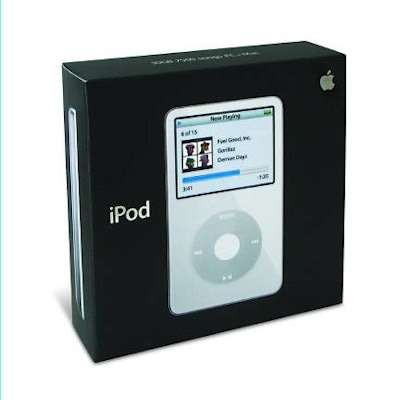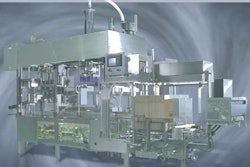
Package design solutions can deliver brands that fulfill consumers' inmost desires; a reaffirmation of their values, a feeling of achieved or aspirational status, a sense of enjoyment, and a growing relationship. These elements satisfy deep emotional needs. Therefore, brands that embody the lifestyle the consumer has, or aspires to have, resonate strongly because they are identified with at the deepest level.
Lifestyle brands can also:
- Generate excitement and buzz.
- Enjoy a cult following.
- Be a status or luxury brand.
- Create a passionate relationship with consumers that precludes their purchase of competing brands.
- Reach a narrow target audience, creating high levels of resonance with those consumers.
- Be perceived as authentic symbols of the consumer's lifestyle and values.
- Move the consumer to purchase out of “love” rather than through more rational feature and benefit motivators.
- Allow consumers to make a statement about their lifestyles.
‘The new big'
Apple's iPod is a lifestyle brand for millions. The iPod digital music player has changed the way people bring their music with them wherever they go. With the launch of the iPod nano model, Apple's first-generation cube design gave way to a slick, ultra-slim, black package that features high-quality photography of the iPod unit on the front and back panels and a silver apple on the spine and cover.
This package has industry analysts remarking that “small (tech packaging) is the new big.” The chic, minimalist designs of Apple's latest products and packaging are now next generation, through visual cues that attract trendsetter consumers.
Strategy: Since cell phones, MP3 players, Blackberries and other digital, hand-held devices are getting smaller and more sophisticated, shouldn't packaging for these products be going in that direction as well?
Spa-like brands
Technologically advanced products and mega brands are seemingly obvious lifestyle choices. But what about the most commonly used, mundane items consumers purchase? How can branding and packaging elevate these products to lifestyle status? More importantly, how can the various elements of packaging refer back to the brand when establishing a lifestyle identity?
Harried consumers are seeking personal care products not only to pamper their bodies, but also to calm their minds and soothe their souls. Accordingly, packaging for personal care items may lend itself to taking the spa branding approach. Because visiting spas requires time commitments and significant expense, many consumers are seeking mass-market products that provide a satisfying home experience instead. Savvy personal-care-product companies are positioning their brands to appeal to the increasingly important self-nurturing lifestyle.
Packaging for these products should engage the senses as expensive spa and salon products do. It should be beautiful to look at: elegant, slim, decorative or structural. It can feature clear bottles that showcase silky, luscious-colored formulas or frosted-looking tubes that make the formulas inside seem pearlized. Color cues can range from soft pastels for relaxing formulas to bright tropicals for invigorating formulas. The packaging can feature high-resolution photography or quality artwork depicting exotic botanicals bespeaking luxurious natural ingredients found at expensive spas and salons. When picked up, the package should feel wonderful in the hand, making consumers want to caress it.
If the products offer the added benefit of essential aromatherapy oils, exotic fragrances, or precious moisturizers, what a great selling point that is when incorporated into the packaging. Tempting consumers to use their sense of smell is part of the spa or aromatherapy experience. Spa packaging is meant to be displayed on the vanity; it becomes part of the décor of the well-appointed spa bath at home, along with piles of fluffy towels and robes in soft colors.
A product line needn't be high-priced to have the look and feel of a spa line. Calgon has packaged its lifestyle brand for the mass market. Calgon's “Take Me Away” tag line now encompasses more than a line of skin-softening bubble baths. There is now luxurious range of products: mousse body washes, powders and body sprays, moisturizers and foot care formulas. While these products are inexpensive, they don't look the part.
Strategy: How can personal-care products stand out from the myriad bath items, moisturizers and aromatherapy products on the shelf? How can they be packaged to engage as many of the senses as possible and make the consumer feel pampered and nurtured?
Lifestyle food brands
Consumers have been interested in making healthier lifestyle food and beverage choices, spurring tremendous growth in the natural and organic food sectors. Savvy brand managers of mass-market food brands have responded to this trend by providing healthier choices for time-starved consumers. The trick is to make these nutritional products stand out on crowded supermarket shelves.
Consider bottled juices. V8's new V-Fusion vegetable and fruit juice might yield some valuable ideas. The proprietary structural shape of the bottle is distinctive. Columnar, textured, and easy to grasp with one hand, even at 46 oz, the package stands out in the crowded juice aisle. Brightly colored, pressure-sensitive labels feature representations of the fruit/vegetable combos within each flavor profile. The packaging quickly makes a unique and decisive selling point: The consumer can get a full serving of fruits and vegetables by drinking one 8-oz glass of juice. Convenient, healthy, 100% juice.
Strategy: Just as the bottled water category has benefited from proprietary structural packaging as a quick identifier of the brand, so might that concept lend itself to more products in the juice aisle. A unique lifestyle product that offers a complete serving of fruits and vegetables in one glass deserves a unique package. Think form, function, and modern aesthetics.
In the freezer case
Frozen prepared meals are a high-volume category that offers many lifestyle packaging opportunities. Stouffer's Lean Cuisine offers a glimpse into smart lifestyle branding and packaging. The tagline “Do Something Good for Yourself” offers consumers a healthier, but no less convenient, alternative to high-calorie, high-fat fast foods.
Appetizing product photography on the packaging is nothing new, but the menu-like description of a frozen meal is. How about the fact that the description appears in English and Spanish to accommodate a growing Hispanic population? The packaging delivers a very clear impression of restaurant quality food. It's cuisine, convenience, and low-calorie. These concepts resonate as consumers make their product selections.
The packaging is lean (inference: portion control) and features a white background that stands out in frozen-food cases. It is also color-cued by segment; green for the café classics line of chef-inspired dishes, red for comfort classics reminiscent of homemade meals, and yellow for casual fare like French bread pizzas. Each package features the orange Lean Cuisine logo to tie together the family of products.
Other frozen meal brands tell a brand story. Marie Callender's concept of foods prepared with “love by grandma,” comfort foods that we all know and crave, prepared with TLC, a time-saving solution for harried consumers.
Strategy: How can your brand align with consumer lifestyle choices and be color-cued and segmented successfully with packaging? Is there a compelling brand story to be shared with consumers?
Either brands lend themselves to a lifestyle proposition or they don't. Obviously, not every brand can or should be positioned as a lifestyle brand. If it is decided that the brand fits into a specific consumer group's lifestyle, then the product packaging must truly reflect those assets that not only point to that lifestyle, but also truly symbolize it.
Since product packaging delivers brands tangibly into customers' hands, it should be made relevant to their lives, and it should always refer back to the brand and corroborate its assets. For lifestyle brand packaging, a number of successful strategies can be employed to successfully leverage the assets customers identify with and want to assimilate into their own lifestyles.
Structure, size, shape, color cues, and brand communications that either share a brand story or perceptibly unique features are a few packaging elements to consider. But a true underlying lifestyle brand identity and strategy should be the focus before developing any packaging initiatives in the first place.


























